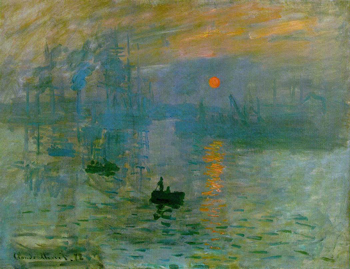| Search Art Prints | ||||||||||||||||||||
| Search Artists | ||||||||||||||||||||

|
||||||||||||||||||||
|
|
|||||||||||||||||||

Impression, Sunrise

|
One of Monet's most famous images, Impression, Sunrise was actually the painting that gave rise to the term Impressionism. Going through and editing the catalogue for an exhibition, Renoir's brother, Edmond, pointed out to Monet the monotony of his titles: View of a Village, with variations. Monet supposedly replied, "Why don't you just call them 'impression?" In the following years, the word was to be widely used by the artists and critics alike.
Indeed, the painting itself demonstrates many of the principles of Impressionism in its composition. Monet himself remarked that it can't really pass for a view of Le Havre's harbor: the painting doesn't really reveal anything. Major landmarks of the harbor are obscured by the early morning mist; the scarlet disc of the sun draws the attention more than anything else, and it overshadows any prominence other objects would have. The clear gray light illuminates the entire canvas, and accounts for the mood of the fishing scene. Monet is clearly more interested in the color of the sky than the topography of the harbor. The painting relies on the artist's perception, not on realistic appearance. It is, quintessentially, an impression.
This painting was also a landmark for Monet's personal growth as an artist: Impression, Sunrise was one of his first major meditations on the essence of light and its importance to the overall nature of a painting. Capturing changing light effects was a theme he was to become increasingly interested in over the next fifty years of his life, and something he would, in time, become a master of.











